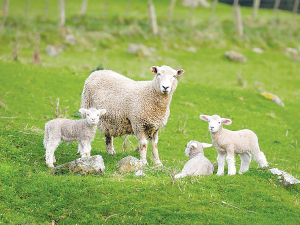Dairy sector profit still on the table, but margin gap tightens
DairyNZ’s latest Econ Tracker update shows most farms will still finish the season in a positive position, although the gap has narrowed compared with early season expectations.
 Ministry for Primary Industries modelling shows that 17.7% of sheep and cattle country would cease running livestock, presumably to be converted to forestry.
Ministry for Primary Industries modelling shows that 17.7% of sheep and cattle country would cease running livestock, presumably to be converted to forestry.
NZ's farming sector has been left disappointed and stunned over the Government's proposal to price agricultural emissions.
Federated Farmers argues the plans would "rip the guts out of small town New Zealand, putting trees where farms used to be". It accuses the Government of throwing out the years of work the sector put into finding a solution and said it was "deeply unimpressed" with the Government's take on what He Waka Eke Noa (HWEN) put forward.
Modelling done by Ministry for Primary Industries shows that without representation - and assuming farmers paid the levies at the farm gate - using the price proposed by HWEN of 11c a kilo of methane, by 2030 production of milksolids would be down by up to 5.9%, lamb down 21.4%, beef down 36.7% and wool down 21.1%.
The same modelling showed that 2.7% of dairy land would go out of dairy production while 17.7% of sheep and cattle country would cease running livestock, presumably to be converted to forestry.
Government modelling also shows that for every tonne of carbon dioxide equivalent reduced under the pricing scheme, about 650 kilograms of greenhouse gas will go up elsewhere in the world. That's because some reduced production in New Zealand will be replaced by higher-emissions production overseas. DairyNZ - a major signatory to HWEN - also has concerns. It says the announcement is "another step" toward a new system. However, the dairy farmer levy body adds that work is needed to "get it right" and make it fair and practical for farmers.
It especially disagrees with changes made to limit the recognition and reward farmers will get for their planting, by removing classes of sequestration like shelterbelts, woodlots and scattered trees.
It is also unhappy with the ability for farmers to form collectives to work together to report, reduce or offset their emissions - a mechanism it argues will drive the change that is needed.
Beef+Lamb New Zealand - the other major HWEN partner - is similarly concerned about the Government's decision to reduce the categories of sequestration recognised. It says sheep and beef farmers will be most heavily affected by a price on agricultural emissions - likely to be exacerbated by these proposed sequestration changes.
The Meat Industry Association (MIA) says while this proposal is better than putting the ag sector into the ETS, it still needs work. MIA points out that lower sheep and beef numbers by 30% since 1990. It adds that NZ's red meat sector is highly emissions efficient, with its carbon footprint around half of the global average.
Consultation runs for six weeks, until Nov 18, with final proposals to go to Ministers for approval in 2023.
The National Wild Goat Hunting Competition has removed 33,418 wild goats over the past three years.
New Zealand needs a new healthcare model to address rising rates of obesity in rural communities, with the current system leaving many patients unable to access effective treatment or long-term support, warn GPs.
Southland farmers are being urged to put safety first, following a spike in tip offs about risky handling of wind-damaged trees
Third-generation Ashburton dairy farmers TJ and Mark Stewart are no strangers to adapting and evolving.
When American retail giant Cosco came to audit Open Country Dairy’s new butter plant at the Waharoa site and give the green light to supply their American stores, they allowed themselves a week for the exercise.
Fonterra chair Peter McBride says the divestment of Mainland Group is their last significant asset sale and signals the end of structural changes.

OPINION: Your old mate welcomes the proposed changes to local government but notes it drew responses that ranged from the reasonable…
OPINION: A press release from the oxygen thieves running the hot air symposium on climate change, known as COP30, grabbed your…